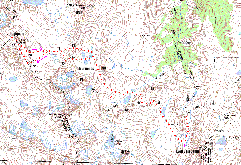annotated map available by clicking the image at left.
The resulting 305 kB GIF-formatted topographic map will take
some time to download if you are reading this via the Internet
and you do not have a high-speed connection. Red dots indicate
the route with roughly 400 feet between dots serving as a scale.
